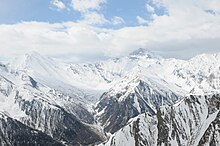Stem tip
| Stammerspitze / Piz Tschütta | ||
|---|---|---|
|
Stammerspitze (right) and Muttler (left) from the northwest |
||
| height | 3254 m above sea level M. | |
| location | Graubünden , Switzerland | |
| Mountains | Samnaun group | |
| Dominance | 2.6 km → Muttler | |
| Notch height | 408 m ↓ Maisasjoch | |
| Coordinates | 821 271 / 198 799 | |
|
|
||
| rock | Mainly dolomite | |
| Age of the rock | Upper Triassic and Lower Jurassic | |
| First ascent | August 16, 1884 by K. Schulze with Johann Nell and Seraphim Kuppelwieser | |
The Stammerspitze ( 3254 m above sea level. M. ), even Stammer Spitz and Piz Tschütta called, is the second highest mountain in the Samnaun group and is located on the territory of the municipality Samnaun in the canton of Grisons in Switzerland .
Location and surroundings
The Stammerspitze located about three kilometers northwest of Muttlers , which with 3294 m highest mountain in the Samnaun group. To the west lies the Val Chöglias , to the south the Val Tiatscha, two side valleys of the Val Sinestra . The Val Maisas, a side valley of the Samnaun, extends to the northeast. To the north and south, the mountain drops with steep rock faces, to the northeast of the summit there is still a small glacier field . In front of the main summit, west-southwest, lies the 3147 m high west summit, which is sometimes also referred to as Piz Tschütta (as opposed to the main Stammerspitz summit ) .
geology
The base of the stem tip is formed by rocks from the Bündner slate . These include limestone , limestone slate , clay slate , sandstone , breccias and conglomerates , most of which come from the Cretaceous , but some older as well as younger formations could be involved. The overlying summit structure, separated from the Bündner schist by a sharp layer boundary, is formed by blue-gray dolomite rock , which tends to form rubble. In particular, the thawing of the permafrost caused by climate change further promotes this, so that the ascent of the mountain becomes more and more dangerous due to the increasing rockfall . Many fossils, especially ammonites, can be found in this limestone, which comes from the Black Jurassic and Triassic .
Paths to the summit
The Stammerspitze is a relatively difficult and rarely climbed mountain. The normal route , which leads from Zuort in the Val Sinestra over the south side through the Mittlere Couloir to the summit, has difficulty level II (UIAA) . The path through the Eastern Couloir is more difficult with III, a variant leads over the Eastern Ridge (IV). The path over the western couloir includes the exposed ridge between the western and main summit (III) and is therefore rarely used. The west summit can also be reached via the Farrar-Couloir or the Direkten Südsporn (II). Other routes lead over the north and east ridge (III) and the west ridge (IV). The path over the north ridge can also be used as a ski tour in a variant from the Val Sinestra .
history
The first attempts at the first ascent of the Stammerspitze are known from A. Arquint and later Gustav Gröger (1879), who were looking for a way over the northwest flank.
In 1881 the Briton John Percy Farrar, Alois Praxmarer from Kaunertal and Heinrich Prinz from Samnaun were able to reach the lower western summit. The higher eastern peak of the Stammerspitze was climbed for the first time on August 16, 1884 by K. Schulze from Leipzig together with Johann Nell and Seraphim Kuppelwieser.
Web links
Individual evidence
- ^ Rudolf Oberhauser, Franz Karl Bauer: The geological structure of Austria . 1st edition. Springer, Vienna / New York 1980, ISBN 3-211-81556-2 , pp. 294 ( books.google.at ).
- ↑ Federal Office for Metrology and Surveying : Austrian Map 1: 50,000, AMAP Online , accessed on October 31, 2010.
- ^ A b c Paul Werner, Ludwig Thoma: Alpenvereinsführer Samnaun group . Ed .: German Alpine Association , Austrian Alpine Association , Alpine Association South Tyrol . 2nd Edition. Rother, Munich 1982, ISBN 3-7633-1241-2 , p. 204-213 .
- ^ Paul Werner, Ludwig Thoma: Alpine Club Leader Samnaun Group . Ed .: German Alpine Association , Austrian Alpine Association , Alpine Association South Tyrol . 2nd Edition. Rother, Munich 1982, ISBN 3-7633-1241-2 , p. 42-43 .


